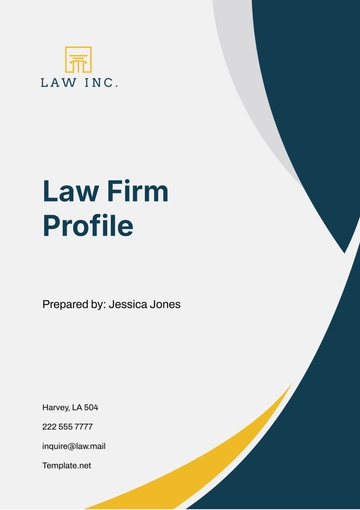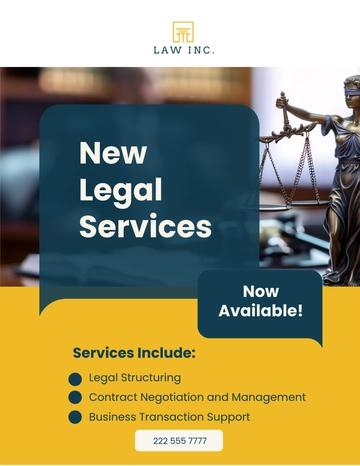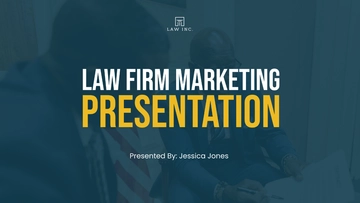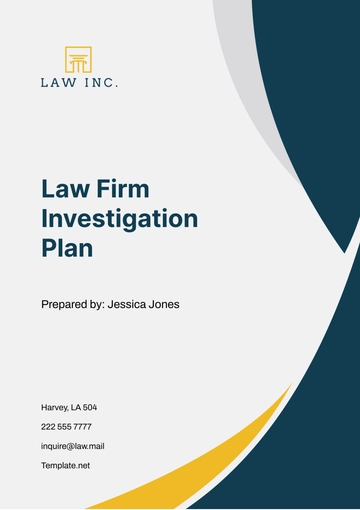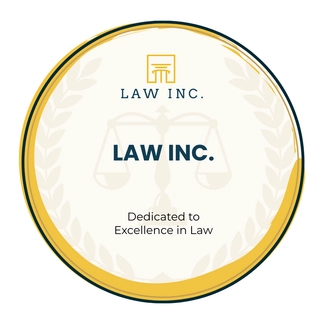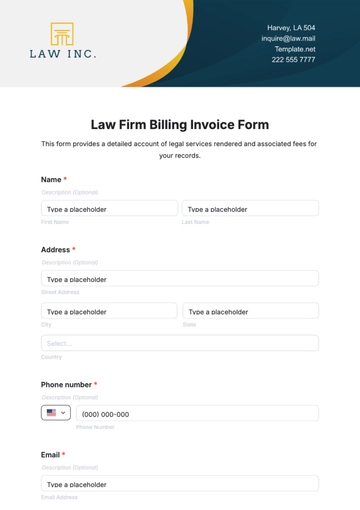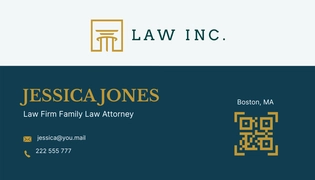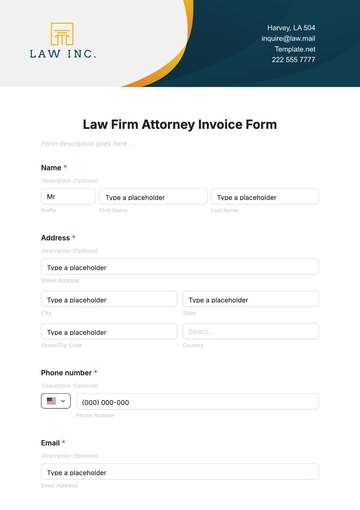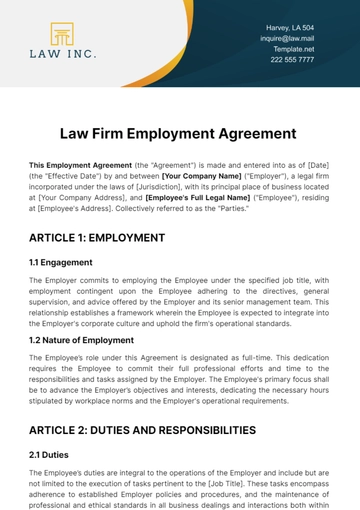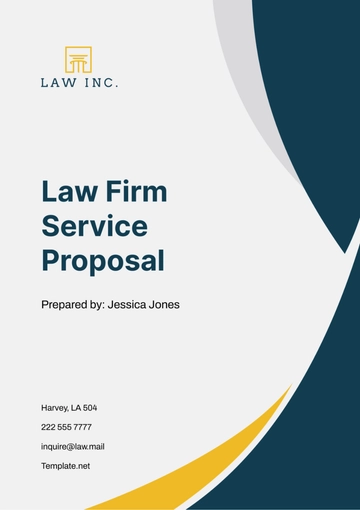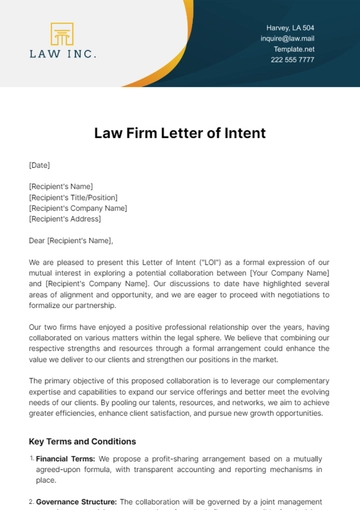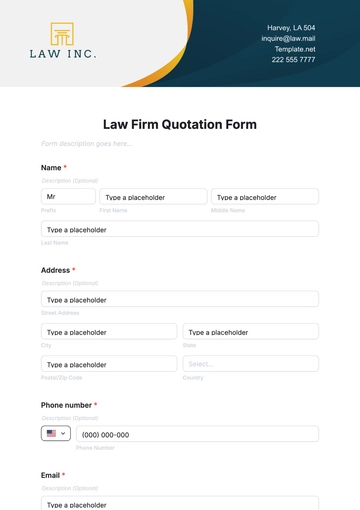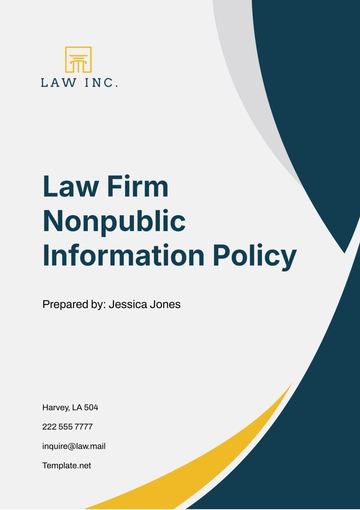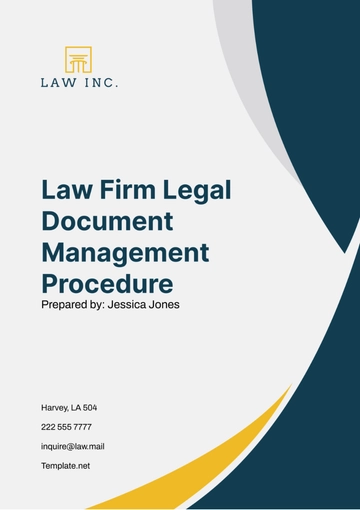Free Law Firm Account Strategy

I. Client Analysis and Segmentation
The cornerstone of our strategy lies in conducting a meticulous examination of our clientele. Through meticulous segmentation based on industry, size, legal requirements, and financial contribution, we gain profound insights into each client's distinct profile. This depth of understanding enables us to finely tune our services and communication strategies to precisely meet the unique needs of every client. By aligning our approach with their specific requirements, we ensure an unparalleled level of service delivery and client satisfaction.
The table below provides a structured overview of our clients, facilitating a targeted approach to meet their unique requirements.
Client Name | Industry | Size | Legal Needs | Revenue Contribution |
|---|---|---|---|---|
[Client 1] | Healthcare | Medium (50-200 beds) | Compliance with Medicare and Medicaid regulations, Employment Law | High - Key Account |
[Client 2] | Rehabilitation | Small (20-50 beds) | Licensing and Certification, Risk Management, Contracts | Moderate - Regular Client |
[Client 3] | Senior Living | Large (200+ beds) | Elder Law, Guardianship, Liability Claims, HIPAA Compliance | High - Key Account |
II. Client Relationship Management
At the heart of our operations lies the commitment to foster enduring relationships with our esteemed clients. Our Client Relationship Management (CRM) strategy is meticulously crafted to ensure the highest level of engagement, satisfaction, and loyalty.
A. Communication Plan
Our communication plan is designed to be both proactive and responsive, ensuring timely and relevant interaction with our clients. This includes:
Structured Touchpoints: Each client is assigned a personalized touchpoint schedule, encompassing regular updates, milestone celebrations, and proactive check-ins.
Multichannel Communication: Leveraging various communication channels such as email, phone calls, virtual meetings, and in-person consultations to accommodate diverse client preferences.
B. Feedback Mechanisms
We understand the importance of actively seeking feedback to continuously enhance our services. Our feedback mechanisms encompass:
Surveys and Interviews: Regularly conducting surveys and interviews to gather insights into client satisfaction, preferences, and areas for improvement.
Feedback Sessions: Hosting feedback sessions to facilitate open dialogue and constructive discussions with our clients, fostering transparency and trust.
C. Client Retention and Loyalty Strategies
Client retention is paramount to our success, and we employ tailored strategies to cultivate enduring loyalty, including:
Personalized Service: Tailoring our services to address each client's specific needs and preferences, demonstrating our commitment to their success.
Value-added Services: Continuously identifying opportunities to provide additional value through educational resources, networking opportunities, and exclusive benefits.
III. Client Service Standards
At [Your Company Name], we uphold a steadfast commitment to excellence in client service. Our Client Service Standards set the benchmark for delivering exceptional service and ensuring client satisfaction. Clear and transparent criteria, including response times, issue resolution procedures, and feedback protocols, are established to guarantee consistency and quality across all client interactions.
Service Standard | Criteria | Description |
|---|---|---|
Response Times | Acknowledgment within 24 hours | All client inquiries, whether via phone, email, or in-person, will be acknowledged within 24 hours. |
Issue Resolution Procedures | Structured process for swift resolution | A structured process is in place to swiftly address and resolve client issues, ensuring minimal disruption. |
Feedback Protocols | Dedicated channels for client feedback | Mechanisms are established for clients to provide feedback, with dedicated channels for voicing concerns or suggestions. |
IV. Cross-Selling and Upselling Opportunities
At [Your Company Name], we recognize the immense potential that lies in cross-selling and upselling our services to existing clients. These opportunities not only contribute to revenue growth but also serve to deepen our relationships with clients by offering tailored solutions to their evolving needs. It is imperative that we approach these opportunities with sensitivity and thoughtfulness, ensuring that they are presented in a manner that adds value to our clients' experiences.
A. Identifying Opportunities
Our first step is to meticulously identify opportunities for cross-selling and upselling within our existing client base. This involves:
Comprehensive Client Analysis: Conducting a thorough analysis of each client's legal needs and identifying areas where additional services could be beneficial.
Understanding Client Objectives: Gaining insights into our clients' long-term goals and objectives to identify opportunities for complementary services.
B. Effective Presentation
Once opportunities are identified, our next focus is on effectively presenting these additional services to our clients. Key strategies include:
Tailored Recommendations: Crafting personalized recommendations that align with each client's specific needs and objectives, demonstrating our commitment to their success.
Educational Approach: Providing educational resources and insights to clients about the value and benefits of additional services, fostering informed decision-making.
C. Respectful Engagement
It is essential that we approach cross-selling and upselling opportunities with the utmost respect for our clients' preferences and boundaries. This involves:
Consultative Approach: Engaging in open and transparent dialogue with clients, allowing them to express their needs and preferences without feeling pressured.
Client-Centric Focus: Placing our clients' best interests at the forefront of every interaction, ensuring that recommendations are aligned with their unique circumstances and objectives.
V. Client Communication Plan
Effective communication is the cornerstone of strong client relationships at [Your Company Name]. Our Client Communication Plan outlines a structured approach to ensure transparency, clarity, and consistency in all client interactions. By detailing communication channels, frequency of updates, key messaging points, and training initiatives, we uphold our commitment to exceptional client service.
Client Communication Plan Procedure
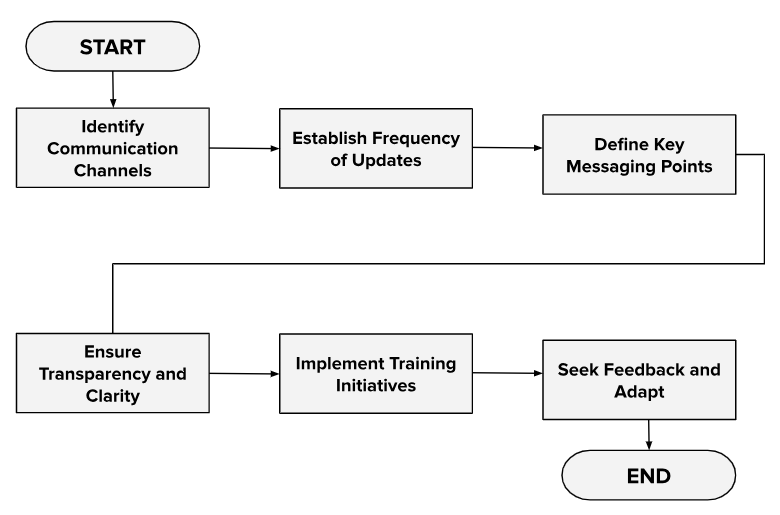
Identify Communication Channels: Determine the most effective channels for communication with each client, including email, phone calls, virtual meetings, and in-person consultations.
Establish Frequency of Updates: Define a schedule for providing regular updates to clients, ensuring they are informed of significant developments in a timely manner.
Define Key Messaging Points: Identify key messages that need to be conveyed to clients, such as case progress, upcoming deadlines, and legal advice.
Ensure Transparency and Clarity: Prioritize transparency and clarity in all communications by using plain language, avoiding jargon, and providing clear explanations.
Implement Training Initiatives: Conduct regular training sessions and refreshers for staff members on communication best practices, emphasizing the importance of client-centric communication.
Seek Feedback and Adapt: Continuously solicit feedback from clients regarding their communication preferences and experiences. Use this feedback to refine and adapt the communication plan as needed, ensuring it remains responsive to client needs and expectations.
VI. Client Satisfaction Measurement and Feedback
At [Your Company Name], we prioritize the continuous improvement of client satisfaction to ensure we consistently meet and exceed our clients' expectations. Our Client Satisfaction Measurement and Feedback process are designed to gather valuable insights and foster constructive dialogue with our clients, ultimately strengthening our relationships and demonstrating our unwavering commitment to exceptional client service.
A. Feedback Gathering Methods
We employ various methods to gather feedback from our clients, including:
Surveys: Utilizing structured surveys to collect quantitative data on client satisfaction and identify specific areas for improvement.
Interviews: Conducting one-on-one interviews with select clients to delve deeper into their experiences and gather qualitative insights.
Informal Conversations: Encouraging open and candid discussions with clients during meetings or casual interactions to solicit real-time feedback.
B. Feedback Utilization Strategies
Once feedback is collected, we implement clear strategies for effectively utilizing this valuable information, including:
Analysis and Action Planning: Analyzing feedback data to identify trends, strengths, and areas for improvement. Developing action plans to address identified issues and enhance client satisfaction.
Communication and Transparency: Communicating with clients transparently about the actions taken in response to their feedback, demonstrating our commitment to continuous improvement.
Client Engagement and Follow-Up: Engaging clients in the feedback process and following up to ensure their concerns have been addressed satisfactorily, fostering trust and loyalty.
VII. Client Growth and Expansion Strategies
Maximizing growth and expanding our business with existing clients is a cornerstone of our firm's success. By strategically identifying and pursuing opportunities within our clients' organizations, leveraging referrals, and staying ahead of emerging legal needs, we not only strengthen our client relationships but also drive sustainable business growth. Our approach is grounded in setting clear goals for each strategy and diligently monitoring progress to ensure successful outcomes.
Cross-Selling Additional Services: Identifying opportunities to offer additional legal services that complement our existing offerings.
Upselling Premium Service Packages: Offering premium service packages or retainer agreements to clients with evolving or expanding legal needs.
Targeting New Business Units or Departments: Identifying and pursuing opportunities to provide legal services to new business units or departments within our existing clients' organizations.
Referral Programs: Implementing structured referral programs to incentivize clients to refer new business to our firm.
Proactive Legal Needs Assessment: Conducting regular assessments of our clients' evolving legal needs and proactively offering solutions to address emerging challenges.
Strategic Account Management: Assigning dedicated account managers to key clients to foster deeper relationships and identify growth opportunities.
Client Education Initiatives: Providing educational resources and workshops to clients on relevant legal topics, positioning our firm as a trusted advisor and thought leader.
VIII. Client Retention Tactics
Ensuring the longevity of our client relationships is paramount. The following tactics are instrumental in maintaining strong client retention and fostering enduring partnerships.
Personalized Client Care Plans
Regular Check-ins and Status Updates
Timely Issue Resolution
Anticipating and Addressing Client Needs
Implementing Client Feedback Loops
Offering Value-added Services
Celebrating Milestones and Achievements
Proactive Client Education Initiatives
IX. Revenue Growth Strategies
Driving sustainable revenue growth is essential for the long-term success and expansion of our firm. By strategically identifying and implementing growth strategies, we can maximize our financial performance and capitalize on new opportunities. This involves exploring new markets, optimizing fee structures, and increasing billable hours to enhance profitability. Regular monitoring and analysis of revenue streams enable us to make informed decisions and adapt our approach to ensure steady growth.
A. Market Expansion
Expanding into new markets or geographic regions to tap into additional opportunities for growth and client acquisition.
B. Fee Structure Optimization
Reviewing and adjusting fee structures to reflect the value of our services and capture additional revenue from clients.
C. Increasing Billable Hours
Implementing measures to enhance efficiency and productivity to increase billable hours and maximize revenue generation.
D. Continuous Monitoring and Analysis
Regularly monitoring and analyzing revenue streams, client billing, and financial performance to identify trends, opportunities, and areas for improvement.
E. Agile Adaptation
Remaining agile and responsive to market changes and client needs, adjusting our strategies and tactics as required to sustain growth and profitability.
X. Summary and Execution Plan
With all strategies outlined, it's essential to translate them into actionable steps through a comprehensive execution plan. This plan will serve as our roadmap, detailing timelines, responsible teams or individuals, and specific actions to be taken. Regular review meetings will be scheduled to ensure progress and update the plan as needed. Additionally, we'll conduct annual reviews of the overall plan to assess its relevancy and effectiveness in achieving our objectives.
The execution plan will include:
Timeline: Clearly defined timelines for each initiative, ensuring accountability and progress tracking.
Responsibilities: Assigning responsibilities to teams or individuals for the execution of each strategy, fostering ownership and commitment.
Specific Steps: Detailing the specific actions required to implement each strategy effectively, leaving no room for ambiguity.
Review Meetings: Regularly scheduled meetings to review progress, address challenges, and make necessary adjustments to the plan.
Annual Plan Review: Conducting an annual review of the overall plan to assess its alignment with organizational goals and adapt to changing market conditions.
In conclusion, the Law Firm Account Strategy delineates a holistic approach to client management, fostering robust relationships and driving sustainable growth. By adhering to the outlined strategies and executing the detailed plan with precision, [Your Company Name] is poised to elevate client satisfaction, expand market reach, and achieve financial success. With a commitment to ongoing refinement and adaptation, we are primed to navigate challenges, seize opportunities, and uphold our position as a trusted partner in legal representation.
- 100% Customizable, free editor
- Access 1 Million+ Templates, photo’s & graphics
- Download or share as a template
- Click and replace photos, graphics, text, backgrounds
- Resize, crop, AI write & more
- Access advanced editor
Enhance client management with the Law Firm Account Strategy Template from Template.net. This editable and customizable template provides a framework for developing comprehensive strategies tailored to key client accounts. Editable in our Ai Editor Tool, it's essential for deepening client relationships, understanding specific needs, and aligning services to maximize client satisfaction and retention in your law practice.






